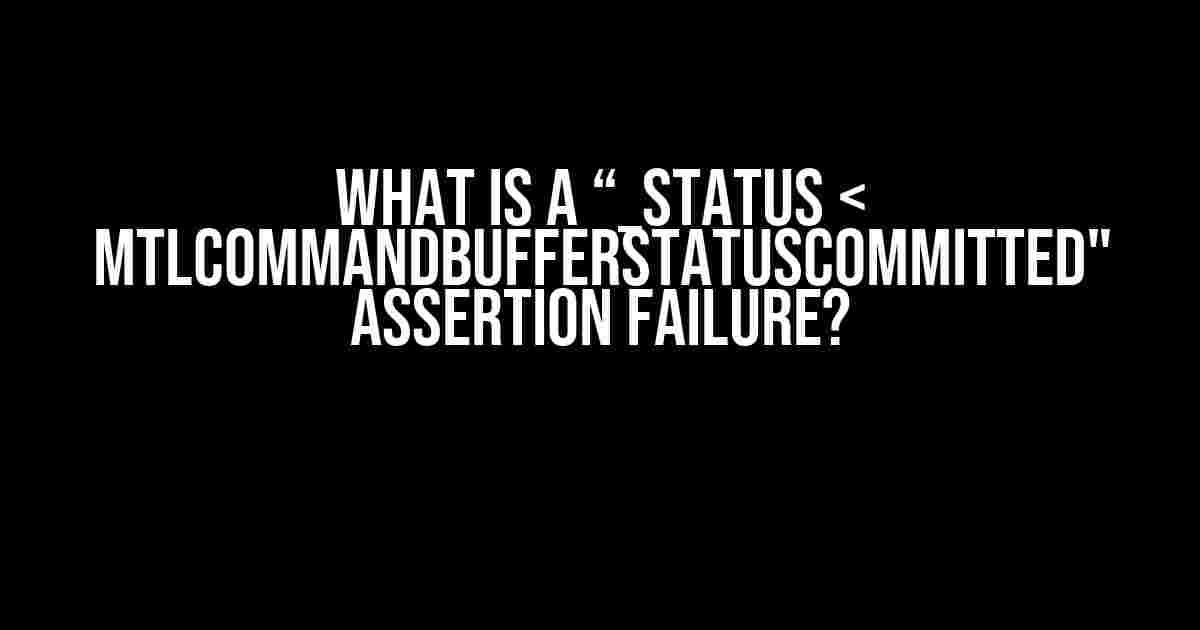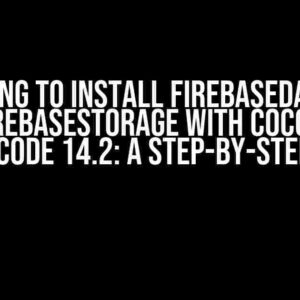If you’re a developer working with Metal APIs, chances are you’ve come across the frustrating “_status < MTLCommandBufferStatusCommitted" assertion failure. This error can be a real showstopper, but fear not! In this article, we'll dive deep into the world of Metal command buffers and explore the reasons behind this error. We'll also provide you with practical solutions to overcome it and get your app running smoothly.
Understanding Metal Command Buffers
Before we dive into the error, let’s take a step back and understand how Metal command buffers work. A command buffer is an object that encapsulates a sequence of commands that are executed by the GPU. These commands can include draw calls, compute kernel executions, and resource management operations.
// Create a command buffer
id<MTLCommandBuffer> commandBuffer = [commandQueue commandBuffer];
// Encode commands
[commandBuffer encodeDrawPrimitives:...];
// Commit the command buffer
[commandBuffer commit];
In the code snippet above, we create a command buffer, encode some commands, and commit the buffer to the GPU. This is a simplified example, but it illustrates the basic flow of using command buffers.
The “_status < MTLCommandBufferStatusCommitted" Assertion Failure
Now, let’s talk about the error at hand. The “_status < MTLCommandBufferStatusCommitted" assertion failure typically occurs when you're attempting to access or modify a command buffer that has already been committed to the GPU. This error is usually triggered by one of the following scenarios:
- Trying to encode commands on a committed command buffer
- Accessing or modifying a resource that’s already been used by a committed command buffer
- Sharing a command buffer between multiple threads or queues without proper synchronization
When you commit a command buffer, you’re effectively handing it over to the GPU for execution. At this point, you should not attempt to modify the buffer or access any resources that are being used by the buffer.
Why Does This Error Occur?
The “_status < MTLCommandBufferStatusCommitted" assertion failure occurs because Metal is designed to ensure that command buffers are executed in the order they were committed. If you attempt to modify a committed command buffer, you risk introducing concurrency issues, data corruption, or even GPU crashes.
By asserting that the command buffer’s status is less than MTLCommandBufferStatusCommitted, Metal is ensuring that you’re not trying to mess with a buffer that’s already been handed over to the GPU.
Solutions to Overcome the Error
Now that we’ve explored the reasons behind the error, let’s dive into some practical solutions to overcome it:
1. Create a New Command Buffer
The simplest solution is to create a new command buffer for each frame or batch of commands. This ensures that you’re never attempting to modify a committed buffer.
// Create a new command buffer for each frame
id<MTLCommandBuffer> commandBuffer = [commandQueue commandBuffer];
// Encode commands
[commandBuffer encodeDrawPrimitives:...];
// Commit the command buffer
[commandBuffer commit];
2. Use a Command Buffer Pool
Another approach is to use a command buffer pool, which allows you to reuse command buffers that have already been committed. This can improve performance by reducing the overhead of creating new command buffers.
// Create a command buffer pool
id<MTLCommandBuffer> commandBufferPool = [commandQueue commandBufferPool];
// Get a command buffer from the pool
id<MTLCommandBuffer> commandBuffer = [commandBufferPool commandBuffer];
// Encode commands
[commandBuffer encodeDrawPrimitives:...];
// Commit the command buffer
[commandBuffer commit];
// Return the command buffer to the pool
[commandBufferPool returnCommandBuffer:commandBuffer];
3. Synchronize Access to Command Buffers
If you’re sharing command buffers between multiple threads or queues, ensure that you’re synchronizing access to these buffers. You can use synchronization primitives like dispatch semaphores or locks to ensure that only one thread or queue can access the buffer at a time.
// Create a dispatch semaphore
dispatch_semaphore_t semaphore = dispatch_semaphore_create(1);
// Encode commands on thread 1
dispatch_async(dispatch_get_global_queue(DISPATCH_QUEUE_PRIORITY_HIGH, 0), ^{
dispatch_semaphore_wait(semaphore, DISPATCH_TIME_FOREVER);
id<MTLCommandBuffer> commandBuffer = [commandQueue commandBuffer];
[commandBuffer encodeDrawPrimitives:...];
[commandBuffer commit];
dispatch_semaphore_signal(semaphore);
});
// Encode commands on thread 2
dispatch_async(dispatch_get_global_queue(DISPATCH_QUEUE_PRIORITY_HIGH, 0), ^{
dispatch_semaphore_wait(semaphore, DISPATCH_TIME_FOREVER);
id<MTLCommandBuffer> commandBuffer = [commandQueue commandBuffer];
[commandBuffer encodeDrawPrimitives:...];
[commandBuffer commit];
dispatch_semaphore_signal(semaphore);
});
Best Practices for Using Command Buffers
To avoid the “_status < MTLCommandBufferStatusCommitted" assertion failure, follow these best practices:
- Create a new command buffer for each frame or batch of commands
- Use a command buffer pool to reuse buffers that have already been committed
- Synchronize access to command buffers when sharing them between multiple threads or queues
- Avoid modifying or accessing resources that are being used by a committed command buffer
- Ensure that you’re not attempting to encode commands on a committed command buffer
| Error Scenario | Solution |
|---|---|
| Trying to encode commands on a committed command buffer | Create a new command buffer or use a command buffer pool |
| Accessing or modifying a resource that’s already been used by a committed command buffer | Avoid modifying or accessing resources that are being used by a committed command buffer |
| Sharing a command buffer between multiple threads or queues without proper synchronization | Use synchronization primitives like dispatch semaphores or locks to synchronize access to command buffers |
By following these best practices, you can avoid the “_status < MTLCommandBufferStatusCommitted" assertion failure and ensure that your Metal-based app runs smoothly and efficiently.
Conclusion
In this article, we’ve explored the “_status < MTLCommandBufferStatusCommitted" assertion failure in depth, covering its causes, solutions, and best practices for using command buffers. By understanding how Metal command buffers work and following the guidelines outlined above, you can overcome this error and unlock the full potential of Metal APIs.
Remember, a thorough understanding of command buffers is crucial for creating high-performance, GPU-intensive apps. With practice and patience, you’ll be well on your way to mastering Metal and creating stunning graphics that leave users breathless.
Frequently Asked Questions
Are you stuck with the dreaded “_status < MTLCommandBufferStatusCommitted" assertion failure? Don't worry, we've got you covered! Here are some frequently asked questions to help you troubleshoot and overcome this issue:
What is the “_status < MTLCommandBufferStatusCommitted" assertion failure?
This assertion failure occurs when the Metal command buffer’s status is not committed, indicating that the buffer is not ready to be executed by the GPU. This can happen due to various reasons such as incorrect buffer creation, incomplete encoding, or invalid buffer usage.
What are the common causes of this assertion failure?
Some common causes of this assertion failure include incorrect buffer creation, incomplete or invalid encoding, incorrect buffer usage, and improper synchronization. Additionally, issues with Metal resource allocation, deallocation, or reuse can also lead to this error.
How can I troubleshoot this issue?
To troubleshoot this issue, you can start by checking the command buffer’s status and ensuring that it’s committed before submitting it to the GPU. Verify that the buffer is created correctly, and encoding is complete and valid. Also, review your Metal resource management and synchronization to ensure that it’s properly handled.
Can I use Metal API validation to help debug this issue?
Yes, Metal API validation can be a valuable tool in debugging this issue. By enabling validation, you can get more detailed error messages and insights into what’s causing the assertion failure. This can help you identify the root cause of the problem and fix it more efficiently.
What are some best practices to avoid this assertion failure in the future?
Some best practices to avoid this assertion failure include creating buffers and resources correctly, ensuring complete and valid encoding, using proper synchronization and resource management, and enabling Metal API validation for debugging. Additionally, following Apple’s guidelines and recommendations for Metal API usage can help you avoid common pitfalls and issues.


